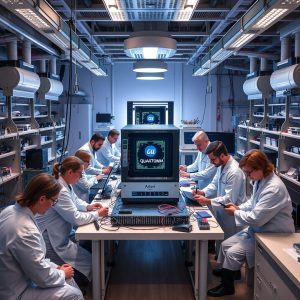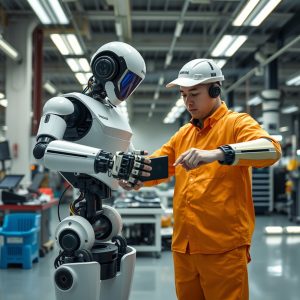
Introduction
As the autonomous vehicle industry accelerates, the development and refinement of self-driving technologies are paramount. A critical component in this technological advancement is the use of virtual environment training simulations. These simulated worlds offer a controlled, versatile, and scalable platform for training and testing autonomous vehicles, ensuring they can handle the complexities of real-world driving.
Industry leaders such as Tesla are at the forefront of utilizing these simulations, driving significant impact on the market and fostering growth opportunities for companies specializing in these advanced virtual environments.
The Role of Virtual Environments in Autonomous Vehicle Training
Virtual environments, or simulation worlds, are computer-generated scenarios that replicate real-world driving conditions. These environments are equipped with sophisticated physics engines to mimic the behavior of vehicles and their interaction with surroundings, including other vehicles, pedestrians, road conditions, and weather patterns.
Key Benefits
- Safety: Simulations allow for the testing of dangerous scenarios without any risk to human life or property. This ensures that autonomous systems can be tested for edge cases, such as sudden pedestrian crossings or severe weather conditions, without real-world consequences.
- Cost Efficiency: Training and testing autonomous vehicles in real-world conditions can be prohibitively expensive. Virtual environments reduce these costs by providing a controlled setting where numerous scenarios can be rapidly tested and iterated.
- Scalability: Virtual environments offer unparalleled scalability. Thousands of scenarios can be run simultaneously, allowing for extensive data collection and faster iteration cycles. This scalability is crucial for developing robust autonomous systems capable of handling diverse real-world conditions.
- Data Generation: These simulations generate vast amounts of data that can be used to train machine learning algorithms, refine sensor technologies, and improve decision-making processes within autonomous systems.
Industry Leaders and Real-World Examples
Tesla
Tesla has been a pioneer in the use of virtual environments for training its autonomous driving systems. The company uses a sophisticated simulation platform to train its neural networks, which are integral to the Autopilot and Full Self-Driving (FSD) systems. Tesla’s approach involves creating highly detailed and dynamic simulation scenarios that mirror the complexities of real-world driving.
Tesla’s simulation platform includes:
- Shadow Mode: A feature that runs the FSD software in parallel with human drivers, collecting data on discrepancies between human and AI responses.
- Simulation Scenarios: Replicating rare and dangerous scenarios that the vehicles encounter in the real world to further train and validate the AI.
By leveraging these virtual environments, Tesla continuously updates and refines its autonomous driving algorithms, contributing to the overall safety and reliability of its vehicles.
Waymo
Another industry leader, Waymo, uses simulation extensively to test its autonomous driving technology. Waymo’s virtual environment, known as CarCraft, simulates thousands of unique driving scenarios, from common everyday situations to rare and challenging events. CarCraft has been pivotal in helping Waymo achieve over 20 million miles of simulated driving daily, significantly enhancing the company’s ability to train and validate its autonomous systems.
NVIDIA
NVIDIA, a leader in AI and computing, has developed the DRIVE Sim platform, a scalable simulation tool for training and testing autonomous vehicles. DRIVE Sim leverages NVIDIA’s powerful GPUs and AI technologies to create highly realistic simulation environments, allowing for comprehensive testing and validation of autonomous driving algorithms.
Market Impact and Growth Perspectives
The use of virtual environments in training autonomous vehicles is reshaping the automotive industry. Companies that invest in advanced simulation technologies are gaining a competitive edge by accelerating the development and deployment of safe and reliable autonomous systems.
Market Growth
The market for simulation software in the automotive sector is expected to grow significantly. According to a report by MarketsandMarkets, the automotive simulation market is projected to reach USD 2.9 billion by 2025, growing at a CAGR of 12.7% from 2020 to 2025. This growth is driven by the increasing complexity of autonomous systems and the need for efficient and safe testing environments.
Business Opportunities
Companies specializing in creating professional simulation worlds with advanced physics for training autonomous vehicles are poised for substantial growth. These companies provide essential tools that enable automakers and tech companies to:
- Accelerate development timelines.
- Reduce R&D costs.
- Enhance the safety and reliability of autonomous systems.
Future Prospects
As the technology and realism of simulation environments continue to advance, their role in autonomous vehicle development will only become more critical. Future prospects include:
- Integration of real-time traffic data into simulations for even more accurate training scenarios.
- Development of AI-driven scenario generation to uncover new edge cases and challenging situations.
- Expansion of simulation use beyond autonomous vehicles to other areas, such as smart city planning and advanced driver-assistance systems (ADAS).
Business Perspectives for VR Simulation Software environment providers

Investing in companies that provide simulation software for the automotive industry is a strategic move with substantial potential. The demand for advanced virtual environments is rapidly increasing as automakers and tech companies race to perfect autonomous driving technologies. According to a report by Grand View Research, the global market for automotive simulation software is expected to reach USD 4.7 billion by 2027, growing at a CAGR of 13.2%.
This growth is fueled by advancements in computational power and AI applications, which enhance the realism and efficiency of virtual environments. The exponential increase in computational power, driven by innovations in GPUs and cloud computing, is enabling more sophisticated and large-scale simulations.
Companies in this space offer critical solutions that significantly reduce R&D costs, accelerate time-to-market for autonomous vehicles, and improve overall system safety and reliability. Investing in these enterprises not only taps into a growing market but also aligns with the broader trend of digital transformation in the automotive industry.
Invenio: Pioneering in Simulation Technology
INVENIO, a community for specialists and a part of Holik Studios, will be exploring this area because we see great potential in it for upcoming years.
We aim to support inventors and promote the development of new technology by providing a platform for young talented individuals from around the world to connect, share ideas, and collaborate through grants offered by sponsors.
The site also focuses on developing innovative electronic components, microprocessors, sensors, and electronics using the latest technology for our own products and services while providing consulting and product development services for external clients. Our initiative is intended to support R&D departments in companies by gathering talented specialists who share their knowledge and ideas. The editorial team consists of Sylvia Foster, Agnes Lenny, and Lucas Braxton, with a focus not only on engineering, but also on video procesing, finance, SEO strategy, and marketing activities.
Conclusion
Virtual environment training simulations are indispensable in the advancement of autonomous vehicle technology. By providing a safe, cost-effective, and scalable platform for testing and training, these simulations are driving significant progress in the industry. Companies like Tesla, Waymo, and NVIDIA exemplify the profound impact of these technologies, showcasing their potential to revolutionize transportation. As the market for simulation software continues to grow, businesses that innovate and excel in this space are set to thrive, leading the charge toward a future of safe and reliable autonomous vehicles.







I’d like to start by congratulating the author on an excellent article about the use of Virtual Reality (VR) in training autonomous vehicles. The nostalgia I feel while reading your work brings back memories of my own experiences with early simulations, which were often clunky and unresponsive.
It’s astonishing to think that today, companies like Tesla are pushing the boundaries of simulation technology to create realistic environments for testing their autonomous driving systems. The fact that they’ve managed to reduce the need for extensive real-world testing is a testament to the power of VR in this field.
I’d like to offer some additional insights based on my own experience as an expert in this area. Firstly, the use of VR in training autonomous vehicles has several key benefits, including increased safety, cost efficiency, and scalability. By simulating various scenarios, developers can test their algorithms without putting humans at risk, which is a crucial advantage.
Secondly, I’d like to emphasize the importance of data generation in these simulations. The vast amounts of data collected during VR testing can be used to refine machine learning algorithms and improve decision-making processes within autonomous systems.
Now, regarding the market impact and growth perspectives, it’s clear that companies specializing in creating professional simulation worlds with advanced physics will continue to thrive. As automakers and tech companies accelerate their development timelines and reduce R&D costs, the demand for these solutions will only increase.
In terms of business opportunities, I would advise companies to invest in developing AI-driven scenario generation tools that can uncover new edge cases and challenging situations. This will not only enhance the realism of simulations but also ensure that autonomous vehicles are prepared for any eventuality on the road.
Finally, as we look towards the future, I believe it’s essential to integrate real-time traffic data into simulations to create even more accurate training scenarios. Additionally, expanding simulation use beyond autonomous vehicles to other areas such as smart city planning and ADAS will only serve to accelerate innovation in this field.
Overall, I’m delighted to see how VR is revolutionizing the development of autonomous vehicles, and I have no doubt that companies like INVENIO will continue to play a critical role in shaping this exciting industry.
I must say, Sienna Cobb’s comment was a breath of fresh air. It’s clear she knows her stuff when it comes to VR and autonomous vehicle training.
But, I have to ask… are we really making any progress here? We’re still years away from deploying reliable self-driving cars on the roads, and yet we’re already talking about integrating real-time traffic data into simulations? It feels like we’re just adding more layers of complexity without actually tackling the fundamental issues at hand.
Reminds me of that Joker sequel review today. Critics were raving about how “daring” and “groundbreaking” it was, but when you really think about it, wasn’t it just a rehashing of the same old ideas? Same tired tropes, same shallow exploration of themes… And I’m not even getting into the whole Joaquin Phoenix vs. Heath Ledger debate.
Sorry to be such a downer, Sienna, but sometimes I feel like we’re just going through the motions, pretending that innovation is happening when in reality it’s just more of the same old, same old.
What a joke article, written by someone who clearly has no idea what they’re talking about.
“Virtual environment training simulations are indispensable in the advancement of autonomous vehicle technology.” Oh please, have you ever even seen a real-time simulation? The complexity is staggering and it’s not just about replicating real-world driving conditions. It’s about creating a dynamic environment that can mimic any scenario imaginable.
And don’t even get me started on Tesla’s “Shadow Mode” feature. That’s cute, but do you know how much data we’re talking about here? We’re talking petabytes of data being generated every second. And the physics engines used in these simulations are not just simple video games, they’re complex algorithms that require a PhD-level understanding.
And then there’s NVIDIA’s “DRIVE Sim” platform. Oh boy, where do I even begin? Let me tell you, my friend, the real power of simulation lies in its ability to generate realistic scenarios, not just pretty graphics. And have you seen the system requirements for this thing? It’s like trying to run a supercomputer on your laptop.
And what about market growth and business opportunities? Please, that’s just basic research. Anybody can read a report from MarketsandMarkets or Grand View Research and come up with some fancy projections. But do they know anything about the actual technology?
As for INVENIO and their “pioneering” in simulation technology, give me a break. They’re just a bunch of wannabes trying to ride the coattails of established companies like Tesla and NVIDIA.
In conclusion (or should I say, in desperation?), this article is nothing but a shallow attempt at grasping the complexities of autonomous vehicle development. It’s like trying to explain quantum mechanics with a high school math textbook.
As someone who has actually worked on simulation technology for years, I can tell you that it’s not just about creating pretty graphics or running simulations in a controlled environment. It’s about pushing the boundaries of what’s possible and creating realistic scenarios that can be used to train autonomous systems. And that takes expertise, dedication, and a lot of hard work.
So, if you’re going to write an article about simulation technology, at least have the decency to do your research and don’t make me roll my eyes out of my head.